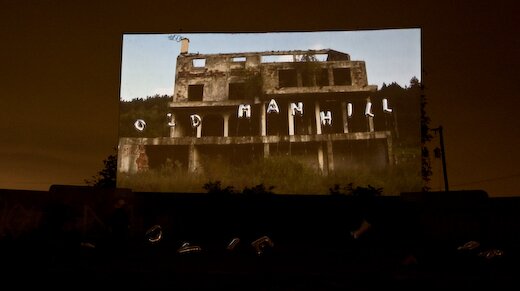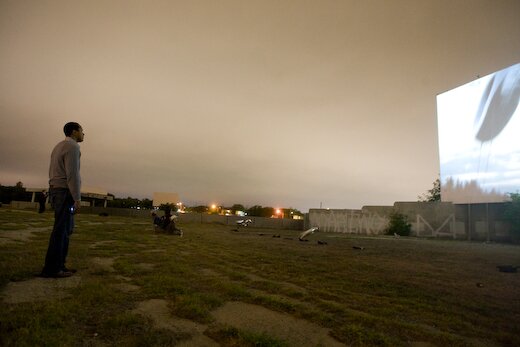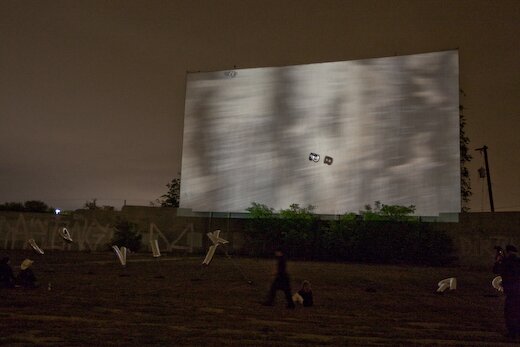Translating Loss
Posted by ben on 20 Apr 2009 at 11:46 am | Tagged as: architecture, arts organizations, celebrations, performance art, public art, r.i.p., video/film
When I was working on my first art review back in 2006, I saw a version of Edgar Arceneaux’s video “Old Man Hill” at the Artpace potluck that launched his residency there. The residency project (which later wound up in the Whitney Biennial) wasn’t as impressive as this simple homage to a man he never met: his father’s father. Arceneaux spelled out the only thing he ever knew about this man — that he was called “Old Man Hill” — in silver balloons, which hovered over the war-torn hills of Sarajevo. One by one the balloons released and twisted toward the sky. The cameras followed the balloons wistfully, clinging to these insubstantial forms seeking oblivion. Occasionally the cameras cut to people going about their lives in the city below, people looking away from these hills with their burned out buildings and piles of rubble.

Linda Pace, who had not yet embarked on her battle with cancer, purchased this piece for her collection. Other than that potluck, the video had never been shown publicly; but before she died, Linda asked that it be screened at a special time, with the artist present. The Linda Pace Foundation arranged to screen the final version of this video for Linda’s birthday, last Thursday. Arceneaux was flown in to stage a performance along with the screening. The site selected for the project was the Mission Drive-In, a once-popular drive-in theater now dilapidated, graffiti-strewn, and slated for destruction. (It will be replaced with a new public library).
The evening of the event was overcast, windy, threatening rain. We got there early, and wandered around the old drive-in, its pavement giving way to grass, but its screens still fully intact. One by one, silver balloons were filled up and placed in front of the main screen, spelling out words that were unfamiliar to us, apparently a translation of “Old Man Hill” into Serbian Bosnian.
The translation of words hinted at another translation: the bombed-out hills of Sarajevo where snipers once found cover were translated into a theater in San Antonio, equally desolate, undergoing a wholly other kind of violence. This isn’t to equate the devestation of war to the disappearance of a drive-in, but to translate loss between cultures. Nearby the old theater, the Mission San Jose holds memories of a violence closer to that of Sarajevo: genocide, slavery, subjugation. But to most of us living in San Antonio today, the loss of place is felt more fully than the tragic, large-scale loss of life experienced by those who lived in Sarajevo in the 1990s or San Antonio in the 1700s. The slow erosion of the identities of our cities happens to be the kind of loss we are stuggling with now, the loss that we still don’t quite know how to grapple with.

Eventually, as it grew dark, Arceneaux introduced the video, speaking of his search to learn something of his grandfather, a man neither he nor his father ever knew. This was a search to connect his identity to something larger, something more historically rooted. He spoke of his brief relationship with Linda Pace, who worked to create places in San Antonio that connect to what came before them: an old car dealership downtown becomes an artist residency space. This is the act of translating place — it doesn’t make sense to have car dealerships downtown anymore, but these spaces can be translated into something that is meaningful today, that turns loss and emptiness into another kind of value.
The video started, and as we watched Old Man Hill float away into the hills of Sarajevo, we also watched indecipherable words from another place float away into the San Antonio night, sometimes brushing slightly against the aging screen. And even as they disappeared from view, these words became embued with meaning. This was the final screening at the Mission Drive-In.

(Photos by Justin Parr, courtesy Linda Pace Foundation)
UPDATE: I’m honored to have Devin King respond to this in the second post on his new blog, Dancing Young Men From High Windows. Hopefully I’ll have time to respond to his post soon, but in the meantime I’ll point yall that way for an interesting reaction.
well said Ben
I loved the silence that fell.
I’m hoping the the park planned for the area just in front of the main screen will find itself full of people watching movies…I suggest Tom Tykwer’s Heaven to get things started…
http://www.tomtykwer.com/03_filmographie/32_heaven/323_entstehung/index.shtml
see you soon
[...] Posted in Uncategorized by devinking on April 20, 2009 My buddy Ben Judson has a nice piece up on his blog describing the last screening at a San Antonio drive-in of Edgar Arceneaux’s video “Old Man [...]
A couple of the architects working on the new library for this site were present at the event. They claimed that the city has intentions to keep one of the four screens intact (the one that the Arceneaux video was projected on). Time will tell, I guess. I’ll keep my fingers crossed.
dear ben,
what a thoughtful and enlightening reading of this work.i enjoyed the linkage that you made here as well, “The translation of words hinted at another translation: the bombed-out hills of Sarajevo where snipers once found cover were translated into a theater in San Antonio, equally desolate, undergoing a wholly other kind of violence. This isn’t to equate the devestation of war to the disappearance of a drive-in, but to translate loss between cultures. Nearby the old theater, the Mission San Jose holds memories of a violence closer to that of Sarajevo: genocide, slavery, subjugation. But to most of us living in San Antonio today, the loss of place is felt more fully than the tragic, large-scale loss of life experienced by those who lived in Sarajevo in the 1990s or San Antonio in the 1700s. The slow erosion of the identities of our cities happens to be the kind of loss we are stuggling with now, the loss that we still don’t quite know how to grapple with.”
this pointing outwards in time to pasts all a part of large a time scape is one that resonates for me. my father is from galvingston and spent his early formative years in beaumont raised by my great grandmother “black mama” i dont know her real name either, though im looking at a phote of her now as i write this from livingroom back in pasadena, ca.
this man, old man hill, represents an unconscious blank, an inaccessible space that is untheorizable, because i can gain no objective position to it, for its too bound up in emotions to ever shake free. i believe that the actual experience of extreme physical and mental states like love or physical or emotional pain is something beyond direct communication. so we are limited to metaphors and metaphors are substitutions. i find this as not a flaw, but that which describes reality.
edgar.
ps old man hill was translated into bosnian, not serbian.
A Local Gallery Spreads Its Wings
write but cannot be red
talk but cannot be herd
see but cannot be scene
-90, -70 and -60mv, -90 and -60
that place is crowded like a serbian mensa convention! but seriously, felt? it is possible to love again.
possible to love
It is again.
thought yawl might be interested/engaged by the topic/threads…
// jonCates
Assistant Professor
Film, Video & New Media
The School of the Art Institute of Chicago
Having spent a year in Bosnia, 98-99, and conceding the vast horror of immediate violence compared to the slow subjugation (or civil surrender)of our culture via environment, I found myself just last week commenting to my wife while standing downtown, “Damn these buildings remind me of Sarajevo!”. Beautiful piece!
.
Sarah Carmen
Later, while going through Constantinople, which he also burns down, he stumbles upon a twenty-year-old naked woman who is without the slightest knowledge of anything in the world. She keeps on following him, however he shuns and abuses her, going as far as throwing her into a locked chamber with her leg bleeding, while he himself going to sleep on cushions in another part of the house, and many times meditates on killing her.
convicted under the Criminal Law Amendment Act (1885) for ‘indecently assaulting and carnally knowing’ his 12 year old stepdaughter. Unrepentant, Shiel served sixteen months hard labour in prison, complaining to the Home Secretary about his treatment as per a letter to the publisher Grant Richards shortly after his release. Shiel’s discussion of his crime is disingenuous; he conceals from Richards the identity of his victim in addition to misleading him about her age. Instead he refers to ‘love-toyings’ with an older girl on the cusp of maturity. Nor does Shiel mention the fact that he had known both the girl and her sisters long before his conviction, perhaps intimately, as contemporary letters from one of the sisters to Shiel suggests. When Shiel was convicted he described himself as a ‘clerk and metal worker’, presumably to conceal his identity. He appealed the conviction unsuccessfully.